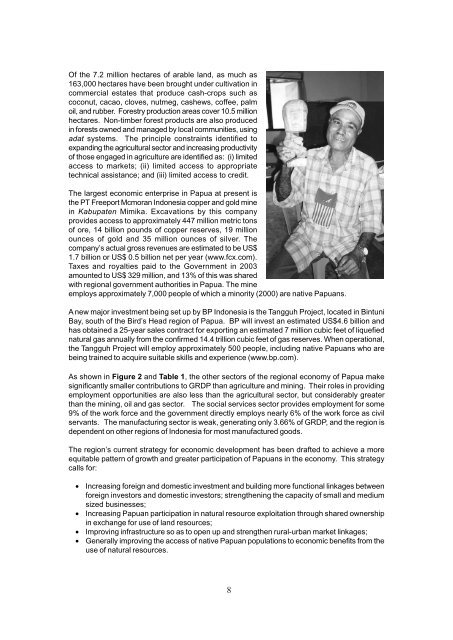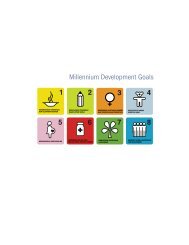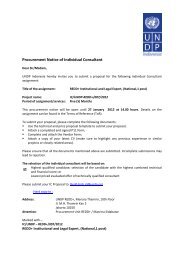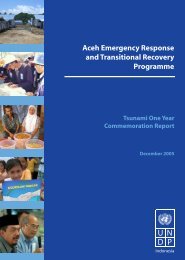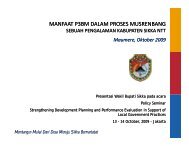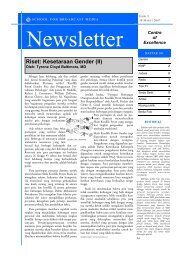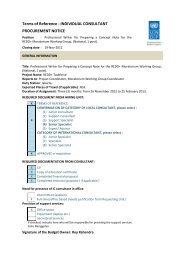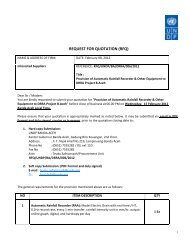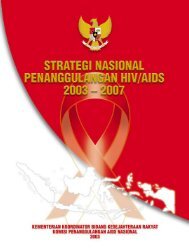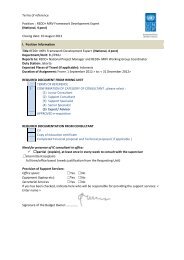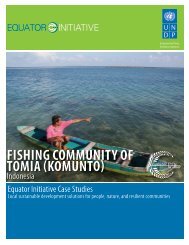Papua Needs Assessment - UNDP
Papua Needs Assessment - UNDP
Papua Needs Assessment - UNDP
Create successful ePaper yourself
Turn your PDF publications into a flip-book with our unique Google optimized e-Paper software.
Of the 7.2 million hectares of arable land, as much as<br />
163,000 hectares have been brought under cultivation in<br />
commercial estates that produce cash-crops such as<br />
coconut, cacao, cloves, nutmeg, cashews, coffee, palm<br />
oil, and rubber. Forestry production areas cover 10.5 million<br />
hectares. Non-timber forest products are also produced<br />
in forests owned and managed by local communities, using<br />
adat systems. The principle constraints identified to<br />
expanding the agricultural sector and increasing productivity<br />
of those engaged in agriculture are identified as: (i) limited<br />
access to markets; (ii) limited access to appropriate<br />
technical assistance; and (iii) limited access to credit.<br />
The largest economic enterprise in <strong>Papua</strong> at present is<br />
the PT Freeport Mcmoran Indonesia copper and gold mine<br />
in Kabupaten Mimika. Excavations by this company<br />
provides access to approximately 447 million metric tons<br />
of ore, 14 billion pounds of copper reserves, 19 million<br />
ounces of gold and 35 million ounces of silver. The<br />
company’s actual gross revenues are estimated to be US$<br />
1.7 billion or US$ 0.5 billion net per year (www.fcx.com).<br />
Taxes and royalties paid to the Government in 2003<br />
amounted to US$ 329 million, and 13% of this was shared<br />
with regional government authorities in <strong>Papua</strong>. The mine<br />
employs approximately 7,000 people of which a minority (2000) are native <strong>Papua</strong>ns.<br />
A new major investment being set up by BP Indonesia is the Tangguh Project, located in Bintuni<br />
Bay, south of the Bird’s Head region of <strong>Papua</strong>. BP will invest an estimated US$4.6 billion and<br />
has obtained a 25-year sales contract for exporting an estimated 7 million cubic feet of liquefied<br />
natural gas annually from the confirmed 14.4 trillion cubic feet of gas reserves. When operational,<br />
the Tangguh Project will employ approximately 500 people, including native <strong>Papua</strong>ns who are<br />
being trained to acquire suitable skills and experience (www.bp.com).<br />
As shown in Figure 2 and Table 1, the other sectors of the regional economy of <strong>Papua</strong> make<br />
significantly smaller contributions to GRDP than agriculture and mining. Their roles in providing<br />
employment opportunities are also less than the agricultural sector, but considerably greater<br />
than the mining, oil and gas sector. The social services sector provides employment for some<br />
9% of the work force and the government directly employs nearly 6% of the work force as civil<br />
servants. The manufacturing sector is weak, generating only 3.66% of GRDP, and the region is<br />
dependent on other regions of Indonesia for most manufactured goods.<br />
The region’s current strategy for economic development has been drafted to achieve a more<br />
equitable pattern of growth and greater participation of <strong>Papua</strong>ns in the economy. This strategy<br />
calls for:<br />
• Increasing foreign and domestic investment and building more functional linkages between<br />
foreign investors and domestic investors; strengthening the capacity of small and medium<br />
sized businesses;<br />
• Increasing <strong>Papua</strong>n participation in natural resource exploitation through shared ownership<br />
in exchange for use of land resources;<br />
• Improving infrastructure so as to open up and strengthen rural-urban market linkages;<br />
• Generally improving the access of native <strong>Papua</strong>n populations to economic benefits from the<br />
use of natural resources.<br />
8


